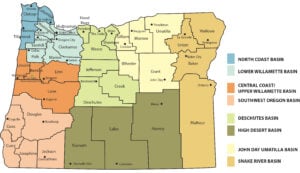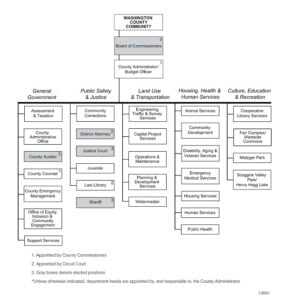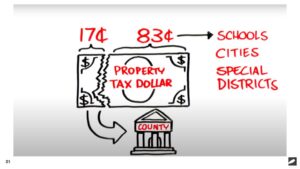
You may have attended a City Council meeting and voted for your State Senator, but what are ways we can participate in government at the County level? What do counties have jurisdiction over and who gets to make decisions? In this post we discuss how Oregon counties operate and how you can get involved!

Did You Know...
Counties actually predate statehood in Oregon and have been providing vital services since 1843!
The Association of Oregon Counties (AOC) was formed in 1906 to share information and build consensus among Oregon counties.
Oregon counties team with the State of Oregon and the federal government to provide many vital public services in an efficient and cost effective manner.
Counties Provide Vital Services
- Maintenance on largest share of Oregon roads
- Issue building permits, conduct inspections, process land use applications
- Recreation: parks, fairs, museums
- Animal control
- Emergency management for disasters such as fires, floods, and earthquakes
- Law enforcement: Sheriffs, operation of jails
- Health and Human Services: public health, early childhood, senior care
- Veterans Services
- County clerks: issue marriage licenses, property deeds, conduct elections
Map of Oregon's 36 Counties

Home Rule History
- Originally, counties functioned almost exclusively as agents of the state government with every activity either authorized or mandated by state law.
- However, in 1958, an amendment to the Oregon Constitution authorized counties to adopt “home rule” charters, and a 1973 state law granted all counties power to exercise broad “home rule” authority.
- As a result, the national Advisory Commission on Intergovernmental Relations has identified county government in Oregon as having the highest degree of local discretionary authority of any state in the nation.
- Nine counties have adopted “home rule” charters, wherein voters have the power to adopt and amend their own county government organization. Lane and Washington were the first to adopt “home rule” in 1962, followed by Hood River (1964), Multnomah (1967), Benton (1972), Jackson (1978), Josephine (1980), Clatsop (1988) and Umatilla (1993).
Home Rule: Immunity and Empowerment
- Empowerment aspect: home rule enables local governments to take action regarding their local affairs without first obtaining authorization from the state legislature to do so. There has been little or no controversy about the empowerment aspect of home rule. The courts have consistently upheld the rights of home rule jurisdictions to act locally on local matters absent any conflict or inconsistency with state law.
- Immunity aspect: home rule protects local governments from legislative interference on matters within their home rule jurisdiction. It has proven to be very complicated and highly controversial. Immunity becomes an issue when both the state and a local government act on the same matter, especially when the state and local actions conflict with each other.
- The ultimate forum for resolving such conflicts is in the court.
Governing Bodies
- Twenty-eight of Oregon’s 36 counties, including the nine with charters, are governed by a board of commissioners comprised of three to five elected members.
- The remaining eight less populated counties are governed by a “county court” consisting of a county judge and two commissioners.
Board of Commissioners
- Comprised of 3-5 elected officials who serve four-year terms.
- Elected at large, serves as the public’s elected advocate, and is the policy making body of County government. The Board’s duties include executive, judicial (quasi-judicial), and legislative authority over policy matters of countywide concern.
- The executive duties include establishment of the budget.
- To implement policy and manage the day-to-day operations of the county, the Board appoints a county administrator.
- Creation and enforcement of county ordinances and, in general, providing constituent services through various county departments. In addition, the Board is involved in a host of regional and community efforts.
County Commissioners from Around the State

Example of a County
Organizational Chart

County Clerks
- Public records for the county.
- Legal Land Documents: Deeds, Mortgages, Contracts, Liens, Easements, Subdivisions, Partition Plats and Military Discharge.
- County Elections: Establishing precincts, registering voters, maintaining voter lists, receiving all nominations and petitions for elections, accepting declarations of candidacy for public office, preparing ballots, receiving and processing votes and coordinates the conduct of elections at the county level.
- Marriage Licenses
- Death Certificates
- Oregon Association of County Clerks
Other Key County Officials
- Sheriff
- Assessor
- Surveyor
- Auditor
- District Attorney

Association of Oregon Counties
- Meets monthly to review issues of interest to counties and make policy and legislative recommendations to the AOC Legislative Committee and the AOC Board of Directors. Information can be found on the AOC website.
- Steering Committees include:
Oregon County Solutions Center
Provides support for county commissioners and judges in convening and participating in collaborative problem solving efforts in their communities and regions. Projects since 2015 include:
- Maritime Workforce Task Force: A legislatively created Task Force.
- Oregon Coast Trail: Supports three commissioners in convening community based stakeholder groups in completing the Oregon Coast Trail from the Washington to California border.
- Project Turnkey: The CARES Act Coronavirus Relief Funds (CRF) offers a unique opportunity for the State of Oregon to partner with county and city governments to create non-congregate shelter needed during the COVID crisis and to make significant progress in addressing long-term housing needs.
- Sudden Oak Death: Task Force on the South Coast to address this tree disease.
- Tide Gates: Convening landowners and agencies in addressing failing tide gates.
Oregon Coastal Zone Management Association: Uniting Local Governments on the Coast
- Any county, city, port, or soil & water conservation district within Oregon’s Coastal Zone can become a member of OCZMA by adopting a resolution joining the Association.
Public Participation: How You Can Get Involved!
- Communicate with your Commissioners. They are people in your community and they want to form relationships with YOU. Call or email your commissioner. Get to know them and address issues that are important to you.
- Monitor Commission agendas to keep track of what decisions are being made.
- Provide written or verbal testimony during Commission meetings.
- Serve on an appointed board, committee or commission. This is a great way to participate in decisions that affect you and to learn more about how your local government works.
Citizen Committees, Boards, and Commissions at the County Level
Citizens are an essential and needed part of the County government process! They serve on a wide variety of platforms. Check out your county's website to see what vacancies you might fill! Examples include:
- County Roads Committee
- Bicycle Committee
- Airport Committee
- Budget Committee
- Public Health Advisory Board
- Ambulance Service Review Committee
- Board of Property Tax Appeals
- Etc.
Public Hearings
- Public testimony can be provided in person, in writing, or virtually.
- Check your county websites for opportunities to participate
- Public meetings law dictates that meetings of governing body be open to public; location of meetings is accessible; disabled persons access; interpreters provided. All meetings of the governing body of a public body shall be open to the public and all persons shall be permitted to attend any meeting except as otherwise provided.
Public Records
- Oregon’s Inspection of Public Records Law (ORS 192.410 to 192.505) gives members of the public the right to inspect and copy public records that are not otherwise exempt from public disclosure. It is the policy of AOC to respond to public records requests as soon as practicable and without unreasonable delay.
- If submitting by email, send the request to: rbovett@oregoncounties.org
- Or check your local county’s website for request instructions.
Oregon's Unique Planning Requirement
- Public involvement is a required part of land use planning goals in Oregon.
- Goal 1 calls for "the opportunity for citizens to be involved in all phases of the planning process." It requires each city and county to have a citizen involvement program that addresses:
-
- Opportunities for widespread public involvement
- Effective two-way communication with the public
- The ability for the public to be involved in all phases of the planning process
- Making technical information easy to understand
- Feedback mechanisms for policy-makers to respond to public input, and
- Adequate financial support for public involvement efforts
The goal also calls for local governments to have a Committee for Citizen Involvement (CCI) to monitor and encourage public participation in planning.
Making and Changing Laws
- The initiative and referendum process is a method of direct democracy that allows people to propose or amend charters or ordinances, or to adopt or reject legislation passed by a local governing body. Learn more HERE.
- If a chief petitioner gathers and submits the required number of signatures, the initiative or referendum is placed on the ballot for voters to adopt or reject.
- A county initiative or referendum must be filed with a County Elections Official
Filing a Local Initiative
- The initiative process gives direct legislative power to the voters to enact new laws, change existing laws, or amend the Oregon Constitution. Any person may be a chief petitioner of an initiative petition. Chief petitioners are the individuals who sponsor initiatives, and an initiative may have up to three chief petitioners.
- To qualify an initiative to the ballot, chief petitioners must file form SEL370 with the local elections official: SEL370: Prospective Petition for Local Measure.
- After receiving the prospective petition, the local elections official forwards the text of the petition to the district or city attorney for drafting of a ballot title. The ballot title impartially summarizes the petition and its major effect.
Initiatives: Signature Gathering
- Chief petitioners may begin gathering signatures once the ballot title is complete, they have received written approval to circulate, and they have reviewed with circulators the legal requirements and guidelines for circulating an initiative petition.
- After gathering the required signatures, the chief petitioner submits them to the local elections official for verification. The official puts the measure on the ballot if the petition contains the required number of signatures.
- The number of valid signatures required to qualify an initiative for the ballot is based on a percentage of the total votes cast at the last election:
- For a county initiative, 6% of the total votes cast in the county for governor.
Referendums
- The referendum process allows voters the opportunity to reject legislation.
- It is a general vote by the electorate on a single political question which has been referred to them for a direct decision.
- Signature Gathering: Chief petitioners can begin gathering signatures after receiving written approval to circulate and reviewing with circulators the legal requirements and guidelines for circulating a referendum petition.
- Signature Verification: After gathering the required number of signatures, the chief petitioner submits them to the local elections official for verification. The official puts the measure on the ballot if the petition contains the required number of signatures.
- The number of valid signatures required to qualify an initiative for the ballot is based on a percentage of the total votes cast at the last election:
- For a county referendum, 4% of the total votes cast in the county for governor.
